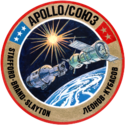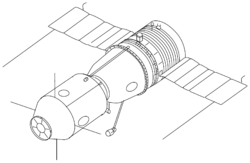Sojuz 18
| Sojuz 18 (Союз-18) | |||
| Modell | Sojuz 7K-T | ||
|---|---|---|---|
| Anrop | Кавказ (Kavkaz - "Kaukasus") | ||
| Färdens tid | 62 dag 23 tim 20 min 8 sek | ||
| Massa | 6 825kg | ||
| NSSDC-ID | 1975-044A[1] | ||
| Uppskjutning | |||
| Startplats | Bajkonur LC1 | ||
| Start | 24 maj 1975, 14:58:10 UTC | ||
| Raket | Sojuz | ||
| Landning | |||
| Landningsplats | 51° N, 68° E | ||
| Landning | 26 juli 1975, 14:18:18 UTC | ||
| Omloppsbana | |||
| Varv | 993 st[2] | ||
| Apogeum | 230 km | ||
| Perigeum | 186 km | ||
| Banlutning | 51,7° | ||
| Besättning | |||
| Besättning | Pyotr Klimuk Vitali Sevastyanov | ||
| Dockning | |||
| Rymdstation | Saljut 4 | ||
| Dockning | 25 maj 1975, 21:30 UTC | ||
| Ur dockning | 26 juli 1975, 10:56 UTC | ||
| Kronologi | |||
| |||
Sojuz 18 (ryska: Союз-18) var en flygning i det sovjetiska rymdprogrammet till rymdstationen Saljut 4. Farkosten sköts upp med en Sojuz-raket från Kosmodromen i Bajkonur den 24 maj 1975. Man dockade med rymdstationen den 25 maj 1975.
Farkosten lämnade rymdstationen den 26 juli 1975, återinträdde i jordens atmosfär och landade i Sovjetunionen några timmar senare.
Sojuz 18 blev den sista bemannade farkost att besöka Saljut 4.
Samtidigt som Klimuk och Sevastyanov befann sig ombord på Saljut 4 genomfördes ASTP. På grund av detta befann sig 7 personer samtidigt i omloppsbana runt jorden, vilket tangerade rekordet från Sojuz 6, Sojuz 7 och Sojuz 8 gemensamma flygning i oktober 1969.
Källor och referenser
- ^ ”NASA Space Science Data Coordinated Archive” (på engelska). NASA. https://nssdc.gsfc.nasa.gov/nmc/spacecraft/display.action?id=1975-044A. Läst 28 februari 2020.
- ^ Manned Astronautics - Figures & Facts Arkiverad 21 december 2015 hämtat från the Wayback Machine., läst 8 oktober 2016.
| |||||||||||||||||||||||||||||||||||||||||||||||||||||||||||||||||||||||||||||||||||||||||
| |||||||
| ||||||||||||||||||||||||||||||||
Media som används på denna webbplats
Författare/Upphovsman: Pascal (Flickr user: pasukaru76), Licens: CC0
Vostok spacecraft replica at the Technik Museum Speyer, Germany.
Soyuz-TM spacecraft. Compare the antennas on the orbital module to those on Soyuz-T. Differences reflect the change from the Igla rendezvous system used on Soyuz-T to the Kurs rendezvous system used on Soyuz-TM.
Apollo-Soyuz Test Project (ASTP) Soyuz. The APAS-75 docking unit is located at left.
The Soyuz TMA-04M spacecraft is seen after being rolled out by train to the launch pad at the Baikonur Cosmodrome in Kazakhstan, May 13, 2012. The launch of the Soyuz spacecraft, with Expedition 31 Soyuz Commander Gennady Padalka, Flight Engineer Sergei Revin of Russia and NASA Flight Engineer Joe Acaba, is scheduled for 9:01 a.m., May 15 (Kazakhstan time).
This is the American crew insignia of the joint United States-USSR Apollo-Soyuz Test Project (ASTP). Of circular design, the insignia has a colorful border area, outlined in red, with the names of the five crew members and the words Apollo in English and Soyuz in Russian around an artist's concept of the Apollo and Soyuz spacecraft about to dock in Earth orbit. The bright sun and the blue and white Earth are in the background. The white stars on the blue background represent American astronauts Thomas P. Stafford, commander; Vance D. Brand, command module pilot; and Donald (Deke) K. Slayton, docking module pilot. The dark gold stars on the red background represent Soviet cosmonauts Aleksey A. Leonov, commander, and Valeriy N. Kubasov, engineer.
Salyut Program insignia.
Soyuz-A manned spacecraft concept (1963). It was to have been part of the Soyuz A-B-C circumlunar complex.














